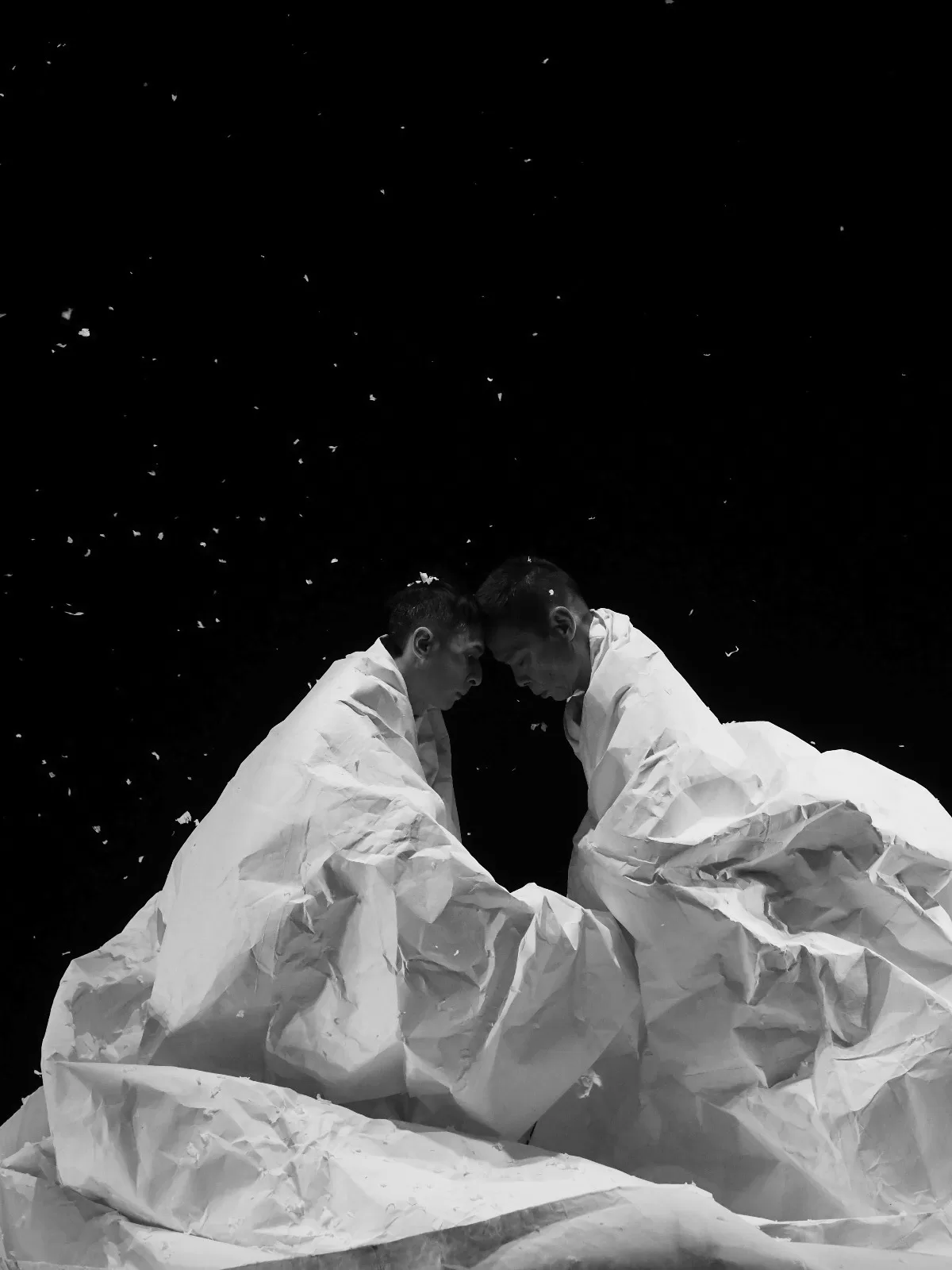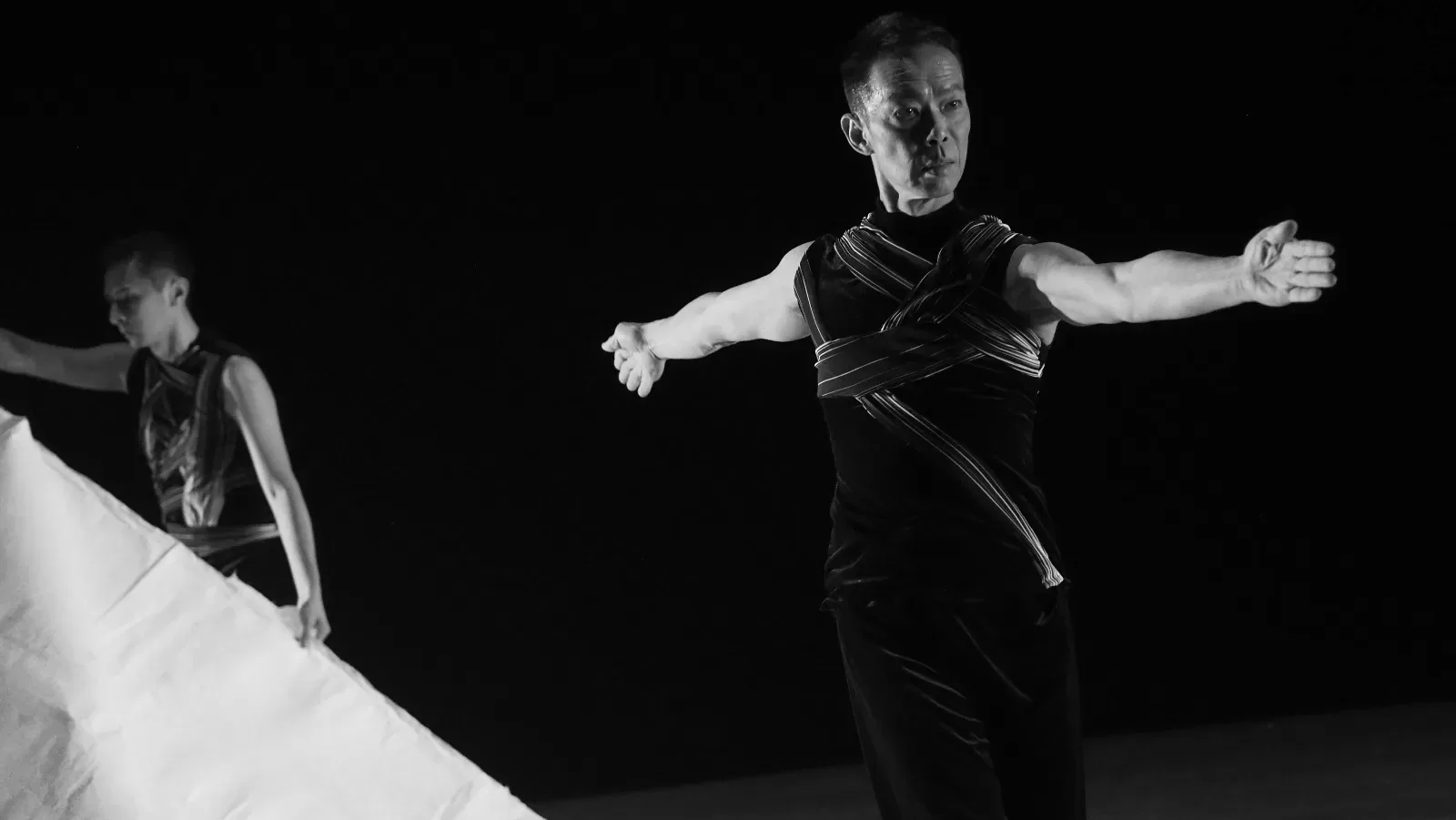The revival of Double Punctum promised a deep exploration of transformation through an interdisciplinary, minimalist approach to dance-theatre. Ming Low and Wong Jyh Shyong—the original duet—delivered a performance marked by arresting presence, technical grace, and subtle collaboration. Their seasoned bodies moved with precision and intentionality. The performance began with the dancers and two crew members unrolling off-white paper across the stage, possibly demystifying the world-creation of dance. Bright white lights reflected off the paper, contrasting sharply with the black vinyl floor, establishing a stark black-and-white dichotomy. Breaking expectations, the dancers began to speak, intertwining oral phrases with movement. Wong’s sharp, disjointed gestures contrasted with Low’s smooth, controlled movements. Their parallel solos culminated in striking, statue-like poses, akin to camera snapshots, a theme revisited in the final scene.
The first scene established qualitative contrasts across the stage, but these tensions were interrupted by booming music and recorded text. The second scene opened with Wong on the white paper and Low on the black floor, accompanied by audio discussions on “becoming.” In a visually engaging moment, Wong tore a circular disc from the paper, and Low emerged through this opening, lit by a pool of white light against a blue backdrop. Low’s gestures conveyed discomfort and awakening as he danced within the circle, while Wong rotated the paper, creating an optical illusion of static centricity.

Subsequent scenes alternated solos and interactions between Low and Wong, often punctuated by blackouts. Each blackout reset the dancers’ positions, analogous to photographic snapshots. As the performance progressed, the metaphorical aperture widened, brightening the stage until the final scene—the most visually and compositionally compelling. In the final scene, the dancers sat with legs concealed beneath the paper, staring at the audience in a moment of suspended anticipation. Slowly, they began crumpling the paper until the whole width of the paper pressed against their bodies. The dancers revisited earlier poses, but now the crumpled paper added a new visual texture, resembling snowy mountain ranges. The performance ended with Low and Wong submerged under the paper, their hands emerging through small holes, invoking themes of transformation and becoming.

Double Punctum presented itself as an investigation of photographic landscapes in form and function. The promised magic of slow theatre emerged most fully in the final scene, where the dancers’ movements eschewed athleticism for poignant stillness.
However, Loh Kok Man’s investigation of human and natural transformation felt didactic, merely grazing the surface of minimalist theatre. While Double Punctum didn’t “stir my emotions” as anticipated, it did provoke reflections on the possibilities of experimental dance-theatre in Malaysia. It was unclear how this version deepened its exploration of movement and themes. The production’s minimalist claims felt undermined by the busy music, layered texts, and semi-strobe lighting, which often distracted the audience. The interplay between text, photographs, set design, and choreography lacked clarity, leaving the audience to question whether the aim was distraction or an embrace of overstimulation. Audience expectations of grace and beauty were met, but those seeking bold experimentation were left wanting.

This revival highlights an appetite for experimental art in Malaysia, suggesting fertile ground for more boundary-pushing works. While Double Punctum aimed to do more by doing less, a more rigorous embrace of “less” could have better aligned with its artistic intentions.
Charissa Lee Yi Zhen (she/her) is a graduate student at Yale University, studying Christian theology, history, liturgy and art.
This review was generated as part of the Artsee Networks Young Arts Writers’ Sandbox Programme, and was published in SUNDAY VIBES of The New Straits Times.


Leave a Reply